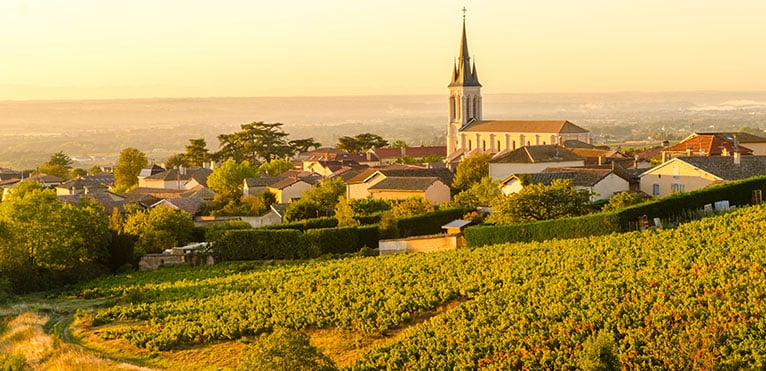
Contents
Beaujolais-villages is a wine appellation covering thirty-one communes in the Rhône and seven in Saône-et-Loire. One of the Beaujolais region’s twelve Protected Designations of Origin (AOC), this prestigious vineyard produces mainly red wines from the Gamay grape, but also a few rare whites (from the Chardonnay grape) and rosés (from the Gamay Noir grape). Some producers also offer “Le Beaujolais-villages nouveau”, a vin primeur that accounts for around 25% of production.
The history of AOC Beaujolais-Villages begins in the 10th century
The history of Beaujolais-Villages dates back to the 10th century, when the Lords of Beaujeu lived in the Château de Montmelas overlooking the region. At the time, the vineyards were under the control of the Abbey of Cluny. The abolition of high Burgundy taxes and the opening of the Briare canal in 1642 led to increased sales, but Beaujolais wines were little known outside the Lyon area until the 1950s.
In 1950, Beaujolais became the first region to officially use the term “village” to designate a very specific part of its AOC. In 1951, the arrival of Beaujolais Nouveau brought worldwide success to the region. This is one of the variations of the Beaujolais-villages appellation, perpetuating the Beaujolais tradition of tasting wine in its prime. Symbolizing a festive, easy-drinking wine, it is enjoyed on the third Thursday in November.
The AOC Beaujolais-Villages terroir boasts quality vineyards
The Monts du Beaujolais border the Beaujolais vineyards to the west, and the Saône River to the east. The Beaujolais-Villages vineyards are located on 5,185 hectares of vines on the slopes of the Monts du Beaujolais, which rise to 700 m or sometimes more than 1,000 m above sea level. Beaujolais has a temperate, semi-continental climate. Sheltered by the Massif Central, it is only slightly affected by Mediterranean disturbances.
Three types of soil characterize the Beaujolais vineyards sandy soils in the north, derived from mainly granitic rocks (poor, filtering, acidic soils), where ten of the Beaujolais appellations are located; the so-called silty-clay soils on the lower slopes of the Beaujolais mountains, where lighter wines are produced; and the deeper, clayey and clay-limestone soils to the south. The vines, which climb to an altitude of 500 meters, are pruned in goblet shape and the wines are vinified “à la beaujolaise” (semi-carbonic maceration).
Beaujolais-Villages are delicious, gourmet wines
Beaujolais vineyards produce mainly red wines, with a few whites and rosés. The grape variety used for Beaujolais-villages wines is Gamay noir à jus blanc for red and rosé, and Chardonnay for white.
Delicious and charming, Beaujolais-villages wines feature a divine divine red color garnet. On the nose, they reveal fragrances of red fruit, with strawberry and blackcurrant predominating. On the palate, they are silky, easy to drink and full-bodied. . Beaujolais-villages are among the short-ageing Beaujolais, with an ageing potential of 1 to 5 years from vintage due to their deliciously fruity character.
Beaujolais-Villages are wines that are easy to drink together.
The harmonious, fruity taste of Beaujolais-villages wines makes them the perfect accompaniment to a wide range of dishes. They’re usually served with red meat, but also terrines, white pudding with apples, Lyon charcuterie, chicken breast en papillotes, filet mignon… Whether they’re called “cabrions” or “boutons de culotte”, the small regional goat’s cheeses known as “chevrotons” make a nice pairing with a young Beaujolais-villages, whose liveliness will enhance the sharp taste. Finally, we suggest a hot brioche sausage to accompany this fruity, easy-drinking wine. Tasting temperature between 12° and 14°.
What are the exceptional vintages of AOC Beaujolais-Villages?
Like any other appellation, Beaujolais-Villages can boast exceptional vintages, taking into account its geological and climatic characteristics. The so-called “millennium vintages” date from 1959 and 1969 and are considered the best years of all. The years 1952, 1961 and 1971 produced exceptional vintages. Recent great vintages include 2005 and 2009.
2 estates to discover in AOC Beaujolais-Villages
Champ-Renard Castle
This estate is located near the village of Blacé, about 40 kilometers northwest of Lyon. This is first and foremost a historic estate, since most of the buildings date back to the 18th century.ème century. In 1765, the Marquis d’Espinay de Laye transformed Château de Champ-Renard into a winery. In 2014, Denis Garnier and Fabienne Vilain became the owners of the Château. The wine is aged in the Château’s traditional vats. In addition, all stages of vinification are carried out at the Château. This winery stands out for its efforts to preserve soil and biodiversity.
Domaine Des Crais
This Beaujolais-Villages winery has been in the Tissier family for 4 generations. It extends over 5.5 hectares on the western slopes of the Mâconnais and on the edge of the Beaujolais mountains in southern Burgundy. Today, Benjamin Tissier is at the helm of this estate, and has been since 2019. The estate produces Mâçon-Fuissé, Saint-Véran, Beaujolais-Village and 3 Beaujolais grands crus: Morgon, Juliénas and Chirouble.